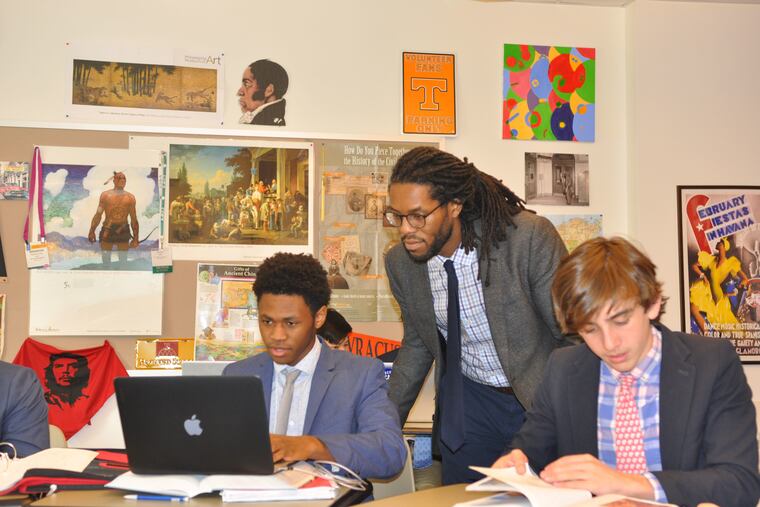To confront the 2020 election cycle, we need emotional intelligence in schools | Opinion
School is often a place where students feel bored, disempowered, and disconnected. Political engagement can help.

In the history classes I teach, I begin with a digital dialogue called “What Gives Us Pause.” Before we begin formal instruction, I invite students to share with each other the social and political currents that worry them most, or make them most hopeful for the future. This dialogue unleashes a flood of student voices.
Every year, students name wars that tear nations apart, gentrification that disrupts the fabric of urban communities, environmental crises, and hate and prejudice. I expect them to talk about the most recent incidents of mass shootings and gun violence right here in Philadelphia. Very quickly, this bonds the classroom in ways that prepare us to support and hold each other accountable, and name patterns of behavior we witness -- in the news cycle, on social media, and in our own lived experiences -- as the year unfolds.
When I began teaching in 2007, the first years felt sterile. I was discouraged from getting too political or confronting social power structures like racism, patriarchy, or class. I was trained to believe that teachers had to create “safe spaces” that were apolitical and socially neutral. We celebrated civil rights victories but did not discuss the dark legacy of slavery. We didn’t talk about the environment. Textbook-driven instruction drove my practice at the expense of student voices and authentic connections with each other.
It is no wonder that school is often a place where students feel bored, disempowered, and disconnected. Political and social engagement can energize classrooms in powerful ways that offer space for processing what matters most to them and managing the stresses of the current social and political climate. We owe it to our kids to close the relevance gap they feel in school.
When stresses from our news cycle enter the classroom, how should teachers respond? How do we engage in constructive dialogue? How do we heal from any hurt caused by traumatic news events, and decide to offer grace to transgressors? How do we confront these moments without dehumanizing each other? These are questions I agonize over with my fellow educators.
Too often, public conversations stop at simply naming transgressions: identifying something as hurtful or difficult and then moving on. In other cases, policy-driven mandates aiming to keep discourse respectful — like bans on the use of specific words, music, readings, or opinions — leave little room for gray areas. School communities, on the other hand, can model practical responses to and discussions of these moments that young people can use their entire lives, including when confronting racism, sexism, and heteronormativity.
The stakes feel high. The special report “Hate at School” by the Southern Poverty Law Center’s Teaching Tolerance project showed a sharp increase in hate and bias in schools since the 2016 election.
Thankfully, the “Hate at School” report offers many entry points for engaging students, educators, and families in inquiry around how to notice, name, and combat acts of bias and hatred on an ongoing basis -- not only when individual moments grow large and public. This defines the work that educators across the nation prepare to engage as school resumes, just over a year out from the 2020 election.
We must cultivate social and emotional intelligence for healthy relationships in schools. Studies suggest that individuals with more developed emotional intelligence have improved social adjustment, and research also has found a link between emotional intelligence and social function as well as high-quality relationships.
From my own experience, here are some tips to promote emotional intelligence and classroom dialogue:
Courageously notice and name acts of bias and hate. Resist the urge to ignore or silence stressful encounters around race, class, gender, religious beliefs, and sexuality. Identifying moments of conflict can create learning opportunities to contradict norms of silence, shallow politeness, or aggression.
Uncover your own story about identity. What early messages about race, gender, class, and sexuality inform the patterns of interaction that they feel capable of noticing and addressing at school? How do these messages shape our interactions with our students?
Consider this emotional work a matter that impacts your health. The stress resulting from these encounters can have significant health effects when left unprocessed or unresolved.
In 2019, silence is not neutral in the face of growing acts of hate and bias in schools. And simply naming inequities — for example, saying “yes, racism in schools exists” — is just a starting point, not a solution in itself.
This fall, I plan to work on empowering my students to bravely confront moments when they feel voiceless, disregarded, or dehumanized. I hope educators, students, and families across the nation continue to notice and respond to moments that harm our communities, in ways that prepare us to face the 2020 election cycle — no matter the result.
Brendon Jobs is director of diversity & inclusion at the Haverford School and a social studies methods instructor at Penn GSE. He serves as vice president of the board of directors for the Waldorf School of Philadelphia and facilitates racial literacy trainings with Lion’s Story Inc.